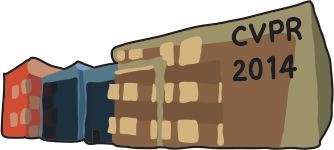-
Is Rotation a Nuisance in Shape Recognition?
AbstractRotation in closed contour recognition is a puzzling nuisance in most algorithms. In this paper we address three fundamental issues brought by rotation in shapes: 1) is alignment among shapes necessary? If the answer is "no", 2) how to exploit information in different rotations? and 3) how to use rotation unaware local features for rotation aware shape recognition? We argue that the origin of these issues is the use of hand crafted rotation-unfriendly features and measurements. Therefore our goal is to learn a set of hierarchical features that describe all rotated versions of a shape as a class, with the capability of distinguishing different such classes. We propose to rotate shapes as many times as possible as training samples, and learn the hierarchical feature representation by effectively adopting a convolutional neural network. We further show that our method is very efficient because the network responses of all possible shifted versions of the same shape can be computed effectively by re-using information in the overlapping areas. We tested the algorithm on three real datasets: Swedish Leaves dataset, ETH-80 Shape, and a subset of the recently collected Leafsnap dataset. Our approach used the curvature scale space and outperformed the state of the art.
Related Material
[pdf][bibtex]@InProceedings{Ke_2014_CVPR,
author = {Ke, Qiuhong and Li, Yi},
title = {Is Rotation a Nuisance in Shape Recognition?},
booktitle = {Proceedings of the IEEE Conference on Computer Vision and Pattern Recognition (CVPR)},
month = {June},
year = {2014}
}
These CVPR 2014 papers are the Open Access versions, provided by the Computer Vision Foundation.
Except for the watermark, they are identical to the accepted versions; the final published version of the proceedings is available on IEEE Xplore.
Except for the watermark, they are identical to the accepted versions; the final published version of the proceedings is available on IEEE Xplore.
This material is presented to ensure timely dissemination of scholarly and technical work.
Copyright and all rights therein are retained by authors or by other copyright holders.
All persons copying this information are expected to adhere to the terms and constraints invoked by each author's copyright.

